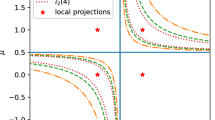Abstract
In this article, we propose a practical scheme for constructing global superconvergent approximations for Maxwell’s equations in both two and three dimensions. Superconvergence of order \(O(h^{p+1})\) is established in a discrete norm. This superconvergence result, combined with the polynomial-preserving recovery postprocessing technique, leads to global superconvergence of order \(O(h^{p+1})\) for recovered quantities in energy norms. Numerical experiments are provided to confirm our theoretical findings.



Similar content being viewed by others
References
Babus̆ka, I., Strouboulis, T., Upadhyay, C.S., Gangaraj, S.K.: Computer-based proof of the existence of superconvergence points in the finite element method; superconvergence of the derivatives in finite element solutions of laplace’s, poisson’s, and the elasticity equations. Numer. Methods Partial Differ. Equ. 12(12), 347–392 (1996)
Brenner, S.C., Scott, L.R.: The Mathematical Theory of Finite Element Methods. Texts in Applied Mathematics. Springer, Berlin (2008)
Cao, W., Shu, C.W., Yang, Y., Zhang, Z.: Superconvergence of discontinuous Galerkin methods for two-dimensional hyperbolic equations. SIAM J. Numer. Anal. 53(4), 1651–1671 (2015)
Cao, W., Zhang, Z., Zou, Q.: Superconvergence of discontinuous Galerkin method for linear hyperbolic equations. SIAM J. Numer. Anal. 52(5), 2555–2573 (2013)
Chen, C.: Structure Theory of Superconvergence of Finite Elements. Hunan Science and Technology Press, Changsha (2001) (in Chinese)
Chen, H., Zhang, Z., Zou, Q.: A recovery based linear finite element method for 1D bi-harmonic problems. J. Sci. Comput. 68(1), 375–394 (2016)
Franz, S., Roos, H.G.: Superconvergence of a Galerkin FEM for higher-order elements in convection–diffusion problems. Numer. Math. Theory Methods Appl. 7(3), 356–373 (2013)
Fuentes, F., Keith, B., Demkowicz, L., Nagaraj, S.: Orientation embedded high order shape functions for the exact sequence elements of all shapes. Comput. Math. Appl. 70(4), 353–458 (2015)
Huang, Y., Li, J., Lin, Q.: Superconvergence analysis for time-dependent Maxwell’s equations in metamaterials. Numer. Methods Partial Differ. Equ. 28(6), 1794–1816 (2012)
Huang, Y., Li, J., Wu, C.: Averaging for superconvergence: verification and application of 2D edge elements to Maxwell’s equations in metamaterials. Comput. Methods Appl. Mech. Eng. 255, 121–132 (2013)
Huang, Y., Li, J., Wu, C., Yang, W.: Superconvergence analysis for linear tetrahedral edge elements. J. Sci. Comput. 62(1), 122–145 (2015)
Huang, Y., Li, J., Yang, W., Sun, S.: Superconvergence of mixed finite element approximations to 3-D Maxwell’s equations in metamaterials. J. Comput. Phys. 230(22), 8275–8289 (2011)
Lin, Q., Yan, N.: The Construction and Analysis of Efficient Finite Element. Hebei University Press, Baoding (1996) (in Chinese)
Monk, P.: A finite element method for approximating the time-harmonic Maxwell equations. Numerische Mathematik 63(1), 243–261 (1992)
Monk, P.: Superconvergence of finite element approximations to Maxwell’s equations. Numer. Methods Partial Differ. Equ. 10(6), 793–812 (1994)
Naga, A., Zhang, Z.: A posteriori error estimates based on the polynomial preserving recovery. SIAM J. Numer. Anal. 42(4), 1780–1800 (2004)
Naga, A., Zhang, Z.: The polynomial-preserving recovery for higher order finite element methods in 2D and 3D. Discrete Contin. Dyn. Syst. Ser. B 5(3), 769–798 (2005)
Nédélec, J.C.: Mixed finite elements in \(\mathbb{R}^3\). Numerische Mathematik 35(1), 315–341 (1980)
Nédélec, J.C.: A new family of mixed finite elements in \(\mathbb{R}^3\). Numerische Mathematik 50(1), 57–81 (1986)
Sun, M., Li, J., Wang, P., Zhang, Z.: Superconvergence analysis of high-order rectangular edge elements for time-harmonic Maxwell’s equations. J. Sci. Comput. 75(3), 1–26 (2017)
Wahlbin, L.B.: Superconvergence in Galerkin finite element methods. Lect. Notes Math. 1605(3), 269–285 (1995)
Xu, J., Zhang, Z.: Analysis of recovery type a posteriori error estimators for mildly structured grids. Math. Comput. 73(247), 1139–1152 (2004)
Zhang, Z.: Finite element superconvergence approximation for one-dimensional singularly perturbed problems. Numer. Methods Partial Differ. Equ. 18(3), 374–395 (2002)
Zhang, Z.: Recovery techniques in finite element methods. In: Tang, T., Xu, J. (eds.). Mathematics Monograph Series 6, vol. 1, no. 3, pp. 333–412. Science Publisher, Beijing (2007)
Zhang, Z., Naga, A.: A new finite element gradient recovery method: superconvergence property. SIAM J. Sci. Comput. 26(4), 1192–1213 (2005)
Author information
Authors and Affiliations
Corresponding author
Additional information
The research of this work was supported in part by the National Natural Science Foundation of China (NSFC 11471031, NSFC 91430216, and NASF U1530401) and the U.S. National Science Foundation (DMS–1419040).
Appendix
Appendix
The other interpolation coefficients in 3D are listed as
with \(0\le k\le p-1\).
with \(0\le j, k\le p-1\).
The other interpolation coefficient in 2D is listed as
Rights and permissions
About this article
Cite this article
Wang, L., Zhang, Q. & Zhang, Z. Superconvergence Analysis and PPR Recovery of Arbitrary Order Edge Elements for Maxwell’s Equations. J Sci Comput 78, 1207–1230 (2019). https://doi.org/10.1007/s10915-018-0805-8
Received:
Revised:
Accepted:
Published:
Issue Date:
DOI: https://doi.org/10.1007/s10915-018-0805-8




